Organisational Culture and Workforce Motivation: Sainsbury Report
VerifiedAdded on 2022/11/29
|16
|4348
|211
Report
AI Summary
This report provides a comprehensive analysis of organisational behaviour, focusing on Sainsbury as a case study. It explores the influence of organisational culture, power, and politics on individual and team performance, examining various cultural models like Charles Handy's typology and the impact of different power dynamics. The report delves into content and process theories of motivation, including Herzberg's two-factor theory and goal-setting theory, to understand how Sainsbury motivates its employees. Furthermore, it differentiates between effective and ineffective teams, discussing the application of hard and soft skills and the Tuckman model of team development. The analysis covers key concepts and philosophies of organisational behaviour, offering insights into how these elements shape the workplace environment and employee outcomes. The report aims to provide a thorough understanding of organisational behaviour principles and their practical application within a business context.
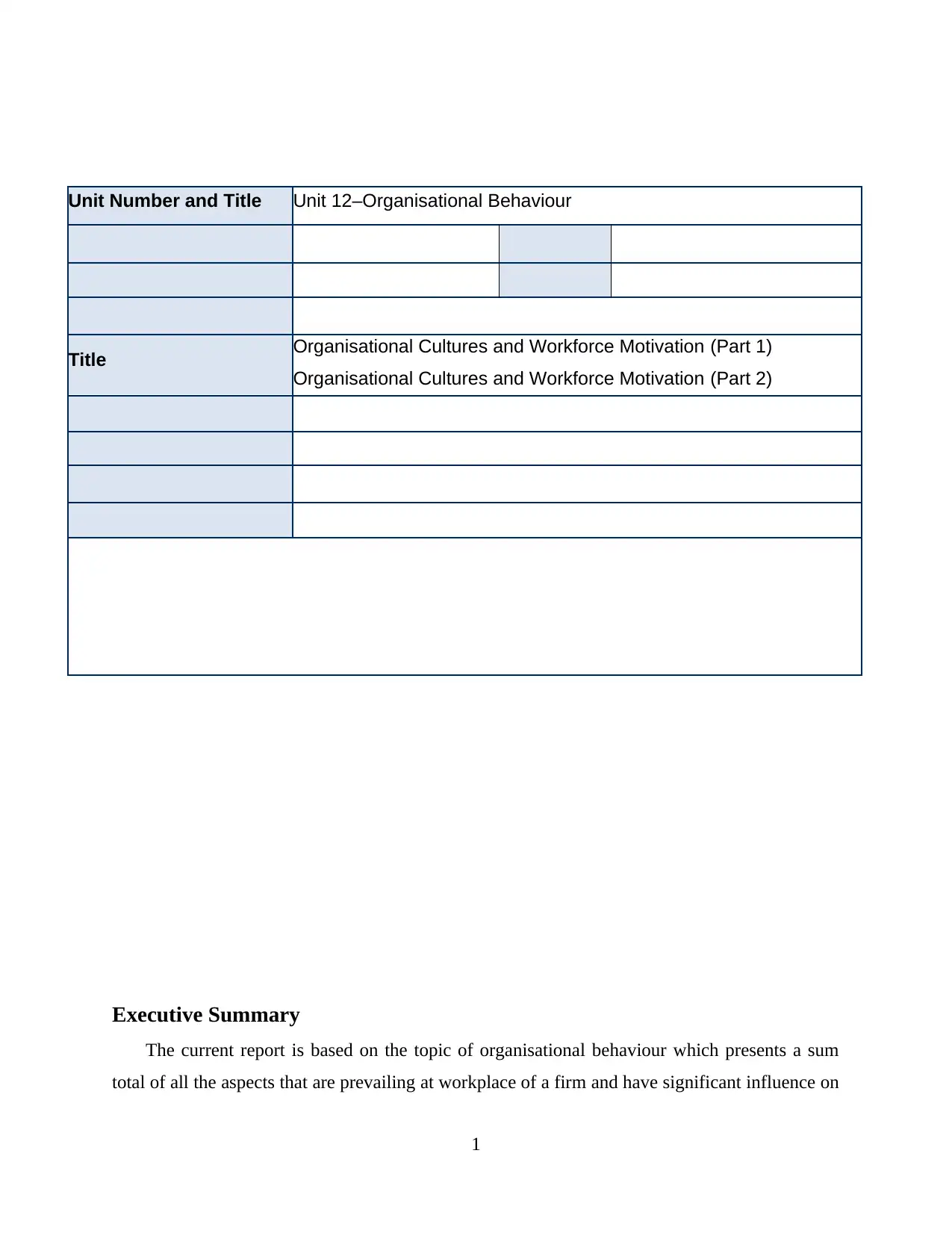
Unit Number and Title Unit 12–Organisational Behaviour
Title Organisational Cultures and Workforce Motivation (Part 1)
Organisational Cultures and Workforce Motivation (Part 2)
Executive Summary
The current report is based on the topic of organisational behaviour which presents a sum
total of all the aspects that are prevailing at workplace of a firm and have significant influence on
1
Title Organisational Cultures and Workforce Motivation (Part 1)
Organisational Cultures and Workforce Motivation (Part 2)
Executive Summary
The current report is based on the topic of organisational behaviour which presents a sum
total of all the aspects that are prevailing at workplace of a firm and have significant influence on
1
Paraphrase This Document
Need a fresh take? Get an instant paraphrase of this document with our AI Paraphraser
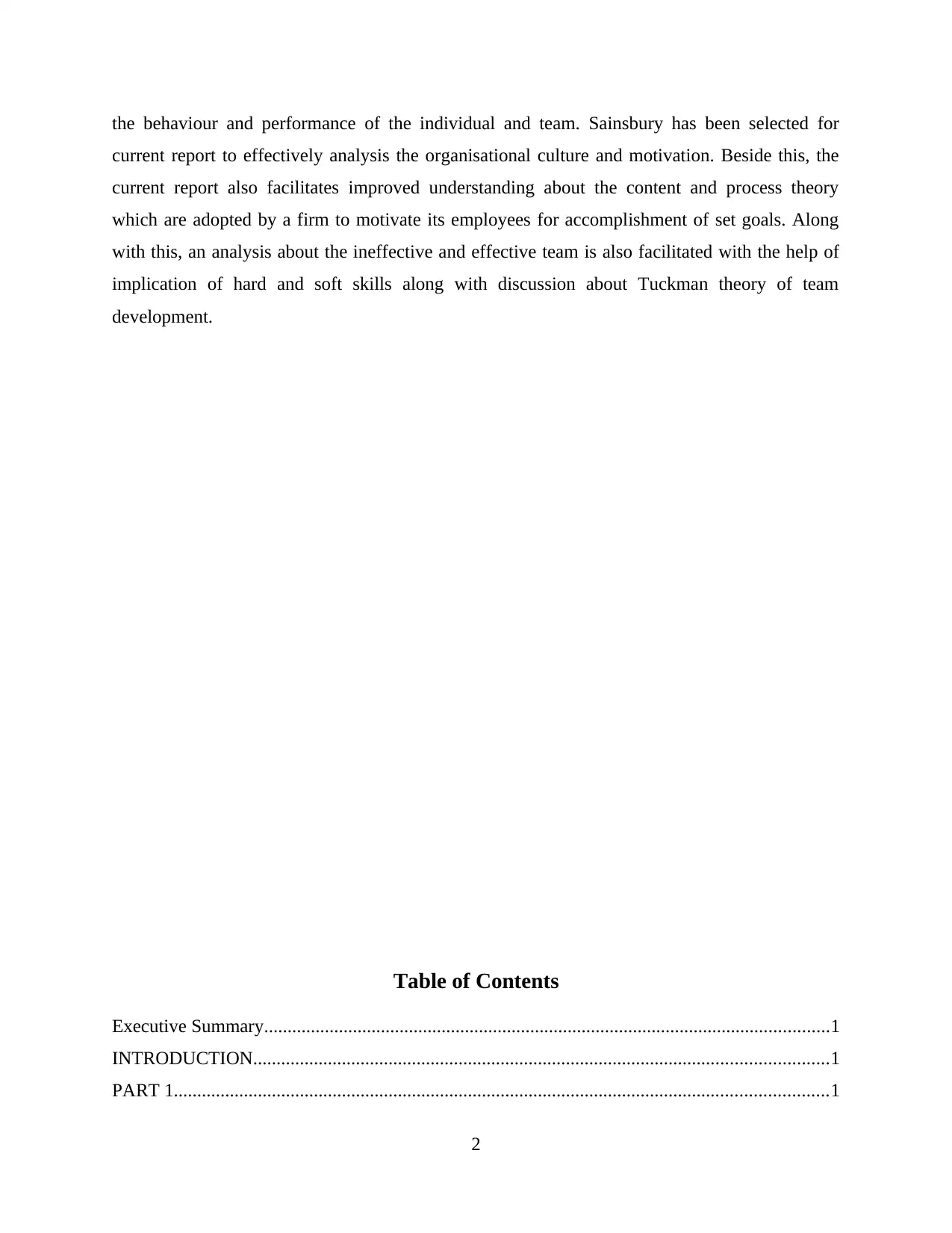
the behaviour and performance of the individual and team. Sainsbury has been selected for
current report to effectively analysis the organisational culture and motivation. Beside this, the
current report also facilitates improved understanding about the content and process theory
which are adopted by a firm to motivate its employees for accomplishment of set goals. Along
with this, an analysis about the ineffective and effective team is also facilitated with the help of
implication of hard and soft skills along with discussion about Tuckman theory of team
development.
Table of Contents
Executive Summary.........................................................................................................................1
INTRODUCTION...........................................................................................................................1
PART 1............................................................................................................................................1
2
current report to effectively analysis the organisational culture and motivation. Beside this, the
current report also facilitates improved understanding about the content and process theory
which are adopted by a firm to motivate its employees for accomplishment of set goals. Along
with this, an analysis about the ineffective and effective team is also facilitated with the help of
implication of hard and soft skills along with discussion about Tuckman theory of team
development.
Table of Contents
Executive Summary.........................................................................................................................1
INTRODUCTION...........................................................................................................................1
PART 1............................................................................................................................................1
2
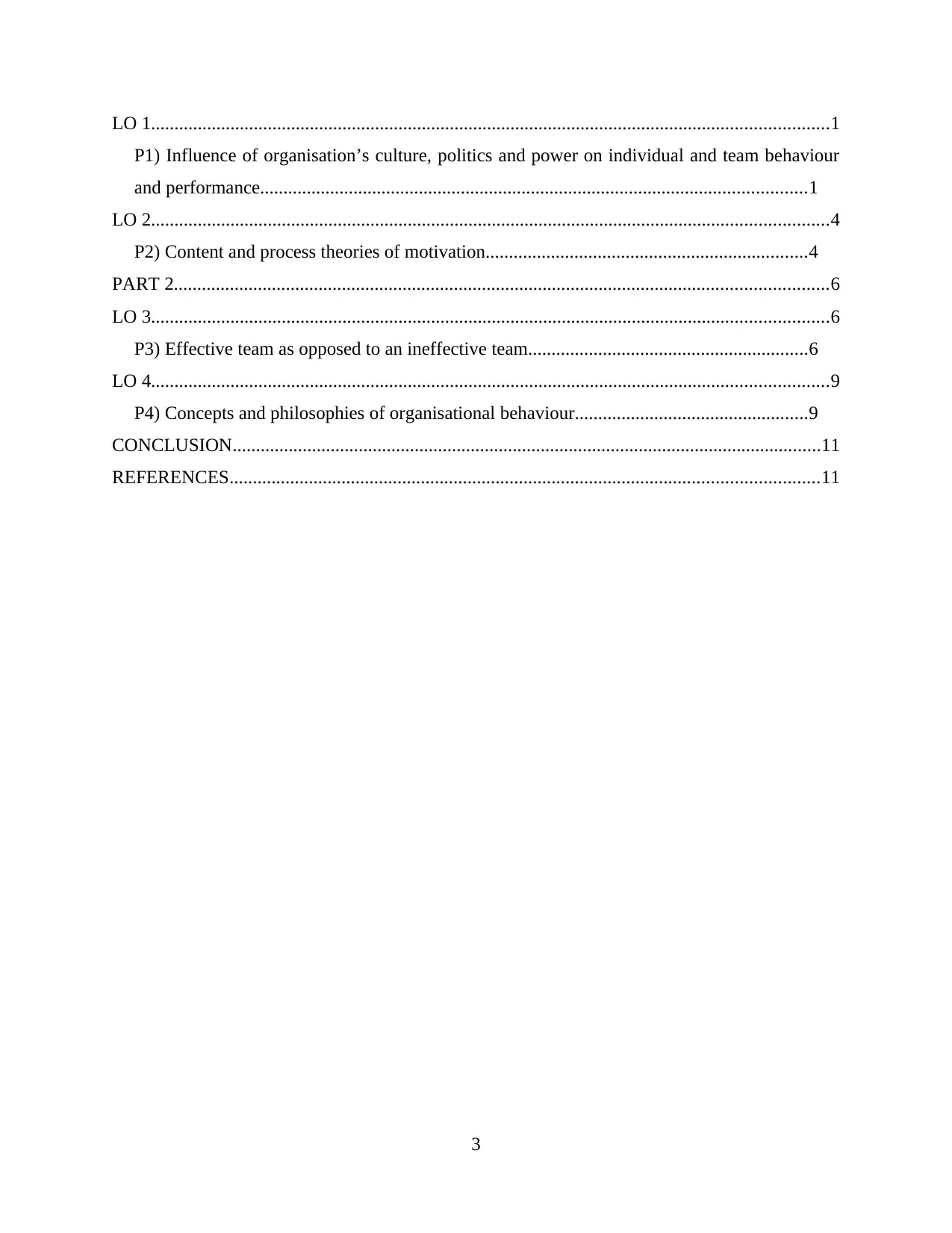
LO 1.................................................................................................................................................1
P1) Influence of organisation’s culture, politics and power on individual and team behaviour
and performance.....................................................................................................................1
LO 2.................................................................................................................................................4
P2) Content and process theories of motivation.....................................................................4
PART 2............................................................................................................................................6
LO 3.................................................................................................................................................6
P3) Effective team as opposed to an ineffective team............................................................6
LO 4.................................................................................................................................................9
P4) Concepts and philosophies of organisational behaviour..................................................9
CONCLUSION..............................................................................................................................11
REFERENCES..............................................................................................................................11
3
P1) Influence of organisation’s culture, politics and power on individual and team behaviour
and performance.....................................................................................................................1
LO 2.................................................................................................................................................4
P2) Content and process theories of motivation.....................................................................4
PART 2............................................................................................................................................6
LO 3.................................................................................................................................................6
P3) Effective team as opposed to an ineffective team............................................................6
LO 4.................................................................................................................................................9
P4) Concepts and philosophies of organisational behaviour..................................................9
CONCLUSION..............................................................................................................................11
REFERENCES..............................................................................................................................11
3
⊘ This is a preview!⊘
Do you want full access?
Subscribe today to unlock all pages.

Trusted by 1+ million students worldwide
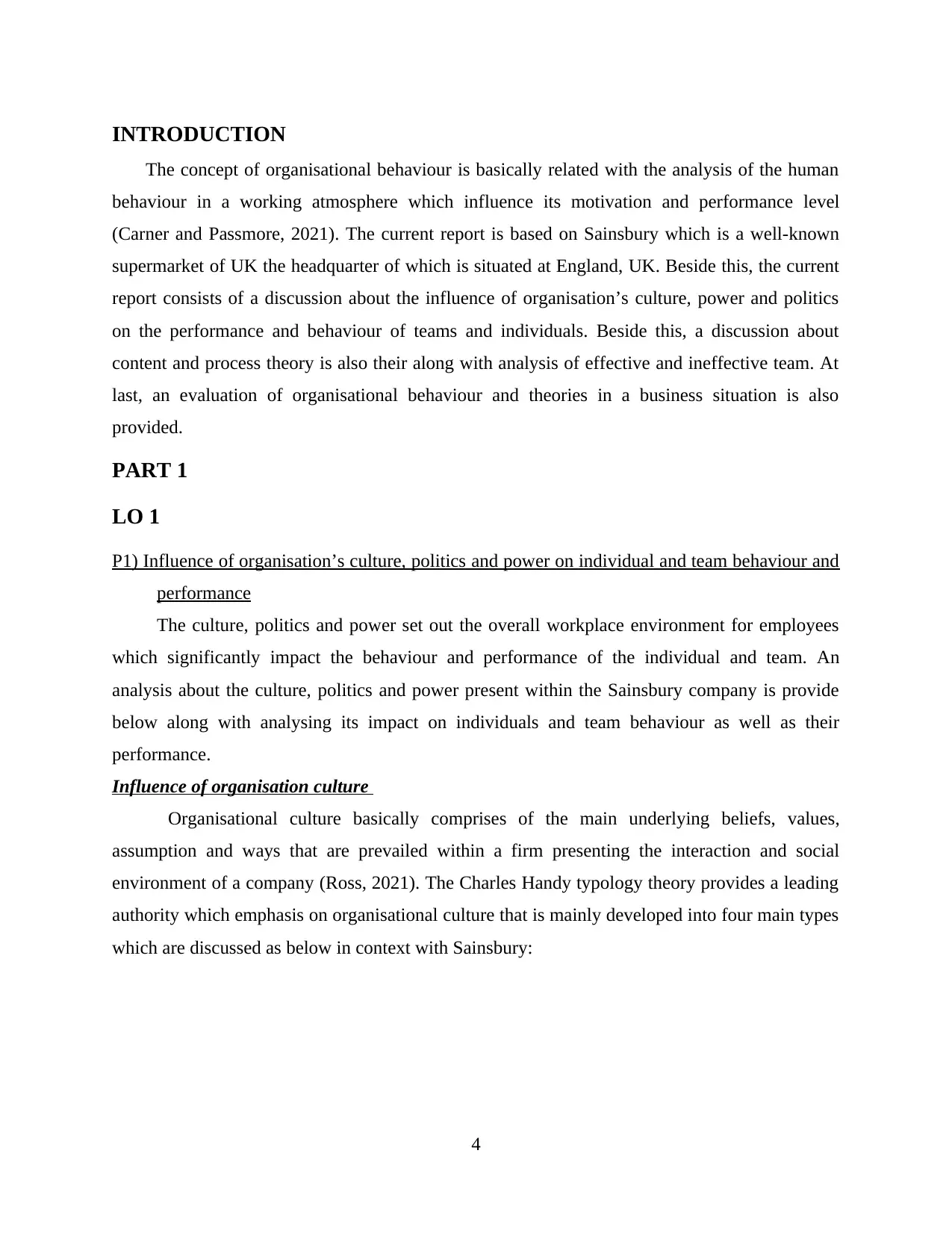
INTRODUCTION
The concept of organisational behaviour is basically related with the analysis of the human
behaviour in a working atmosphere which influence its motivation and performance level
(Carner and Passmore, 2021). The current report is based on Sainsbury which is a well-known
supermarket of UK the headquarter of which is situated at England, UK. Beside this, the current
report consists of a discussion about the influence of organisation’s culture, power and politics
on the performance and behaviour of teams and individuals. Beside this, a discussion about
content and process theory is also their along with analysis of effective and ineffective team. At
last, an evaluation of organisational behaviour and theories in a business situation is also
provided.
PART 1
LO 1
P1) Influence of organisation’s culture, politics and power on individual and team behaviour and
performance
The culture, politics and power set out the overall workplace environment for employees
which significantly impact the behaviour and performance of the individual and team. An
analysis about the culture, politics and power present within the Sainsbury company is provide
below along with analysing its impact on individuals and team behaviour as well as their
performance.
Influence of organisation culture
Organisational culture basically comprises of the main underlying beliefs, values,
assumption and ways that are prevailed within a firm presenting the interaction and social
environment of a company (Ross, 2021). The Charles Handy typology theory provides a leading
authority which emphasis on organisational culture that is mainly developed into four main types
which are discussed as below in context with Sainsbury:
4
The concept of organisational behaviour is basically related with the analysis of the human
behaviour in a working atmosphere which influence its motivation and performance level
(Carner and Passmore, 2021). The current report is based on Sainsbury which is a well-known
supermarket of UK the headquarter of which is situated at England, UK. Beside this, the current
report consists of a discussion about the influence of organisation’s culture, power and politics
on the performance and behaviour of teams and individuals. Beside this, a discussion about
content and process theory is also their along with analysis of effective and ineffective team. At
last, an evaluation of organisational behaviour and theories in a business situation is also
provided.
PART 1
LO 1
P1) Influence of organisation’s culture, politics and power on individual and team behaviour and
performance
The culture, politics and power set out the overall workplace environment for employees
which significantly impact the behaviour and performance of the individual and team. An
analysis about the culture, politics and power present within the Sainsbury company is provide
below along with analysing its impact on individuals and team behaviour as well as their
performance.
Influence of organisation culture
Organisational culture basically comprises of the main underlying beliefs, values,
assumption and ways that are prevailed within a firm presenting the interaction and social
environment of a company (Ross, 2021). The Charles Handy typology theory provides a leading
authority which emphasis on organisational culture that is mainly developed into four main types
which are discussed as below in context with Sainsbury:
4
Paraphrase This Document
Need a fresh take? Get an instant paraphrase of this document with our AI Paraphraser
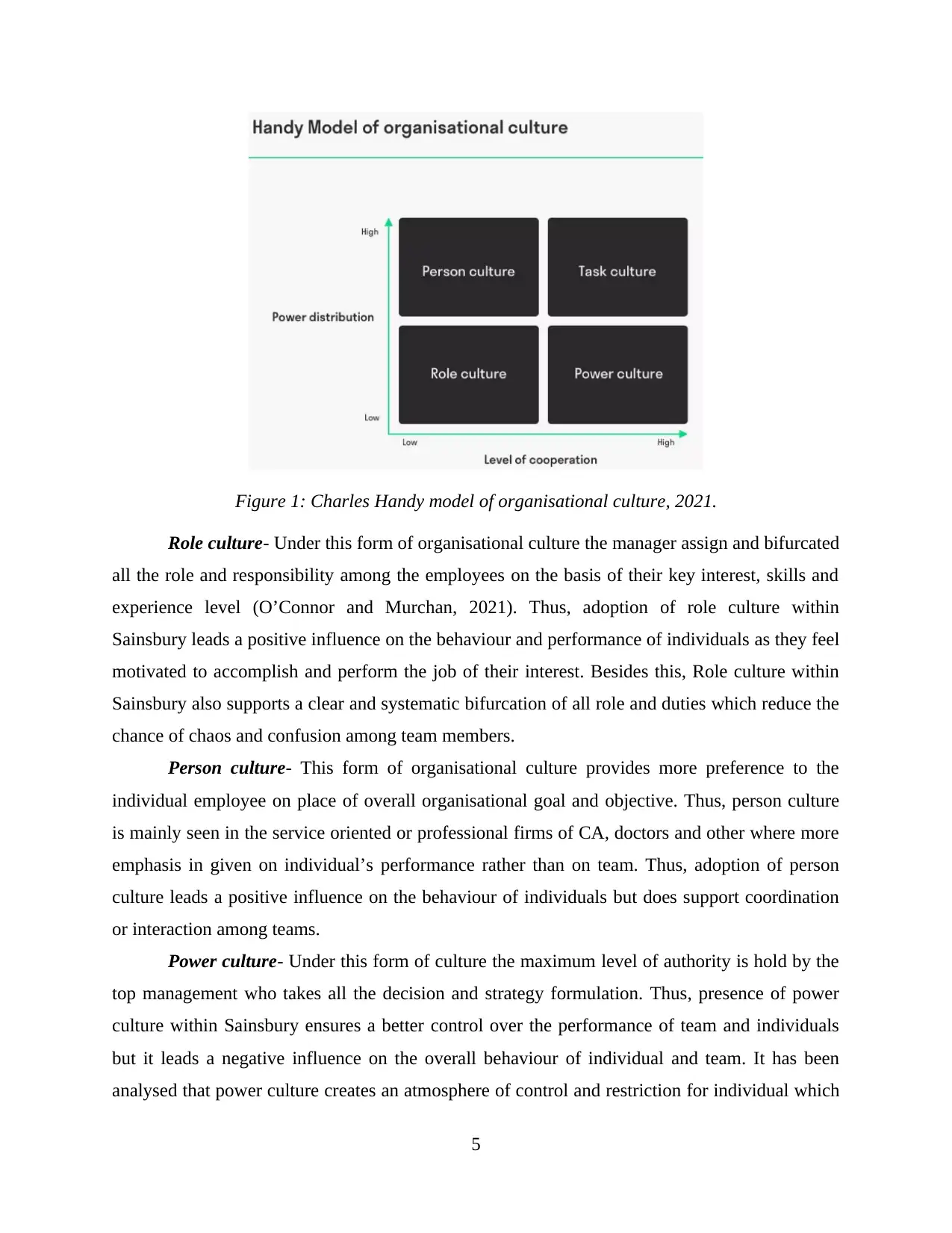
Figure 1: Charles Handy model of organisational culture, 2021.
Role culture- Under this form of organisational culture the manager assign and bifurcated
all the role and responsibility among the employees on the basis of their key interest, skills and
experience level (O’Connor and Murchan, 2021). Thus, adoption of role culture within
Sainsbury leads a positive influence on the behaviour and performance of individuals as they feel
motivated to accomplish and perform the job of their interest. Besides this, Role culture within
Sainsbury also supports a clear and systematic bifurcation of all role and duties which reduce the
chance of chaos and confusion among team members.
Person culture- This form of organisational culture provides more preference to the
individual employee on place of overall organisational goal and objective. Thus, person culture
is mainly seen in the service oriented or professional firms of CA, doctors and other where more
emphasis in given on individual’s performance rather than on team. Thus, adoption of person
culture leads a positive influence on the behaviour of individuals but does support coordination
or interaction among teams.
Power culture- Under this form of culture the maximum level of authority is hold by the
top management who takes all the decision and strategy formulation. Thus, presence of power
culture within Sainsbury ensures a better control over the performance of team and individuals
but it leads a negative influence on the overall behaviour of individual and team. It has been
analysed that power culture creates an atmosphere of control and restriction for individual which
5
Role culture- Under this form of organisational culture the manager assign and bifurcated
all the role and responsibility among the employees on the basis of their key interest, skills and
experience level (O’Connor and Murchan, 2021). Thus, adoption of role culture within
Sainsbury leads a positive influence on the behaviour and performance of individuals as they feel
motivated to accomplish and perform the job of their interest. Besides this, Role culture within
Sainsbury also supports a clear and systematic bifurcation of all role and duties which reduce the
chance of chaos and confusion among team members.
Person culture- This form of organisational culture provides more preference to the
individual employee on place of overall organisational goal and objective. Thus, person culture
is mainly seen in the service oriented or professional firms of CA, doctors and other where more
emphasis in given on individual’s performance rather than on team. Thus, adoption of person
culture leads a positive influence on the behaviour of individuals but does support coordination
or interaction among teams.
Power culture- Under this form of culture the maximum level of authority is hold by the
top management who takes all the decision and strategy formulation. Thus, presence of power
culture within Sainsbury ensures a better control over the performance of team and individuals
but it leads a negative influence on the overall behaviour of individual and team. It has been
analysed that power culture creates an atmosphere of control and restriction for individual which
5
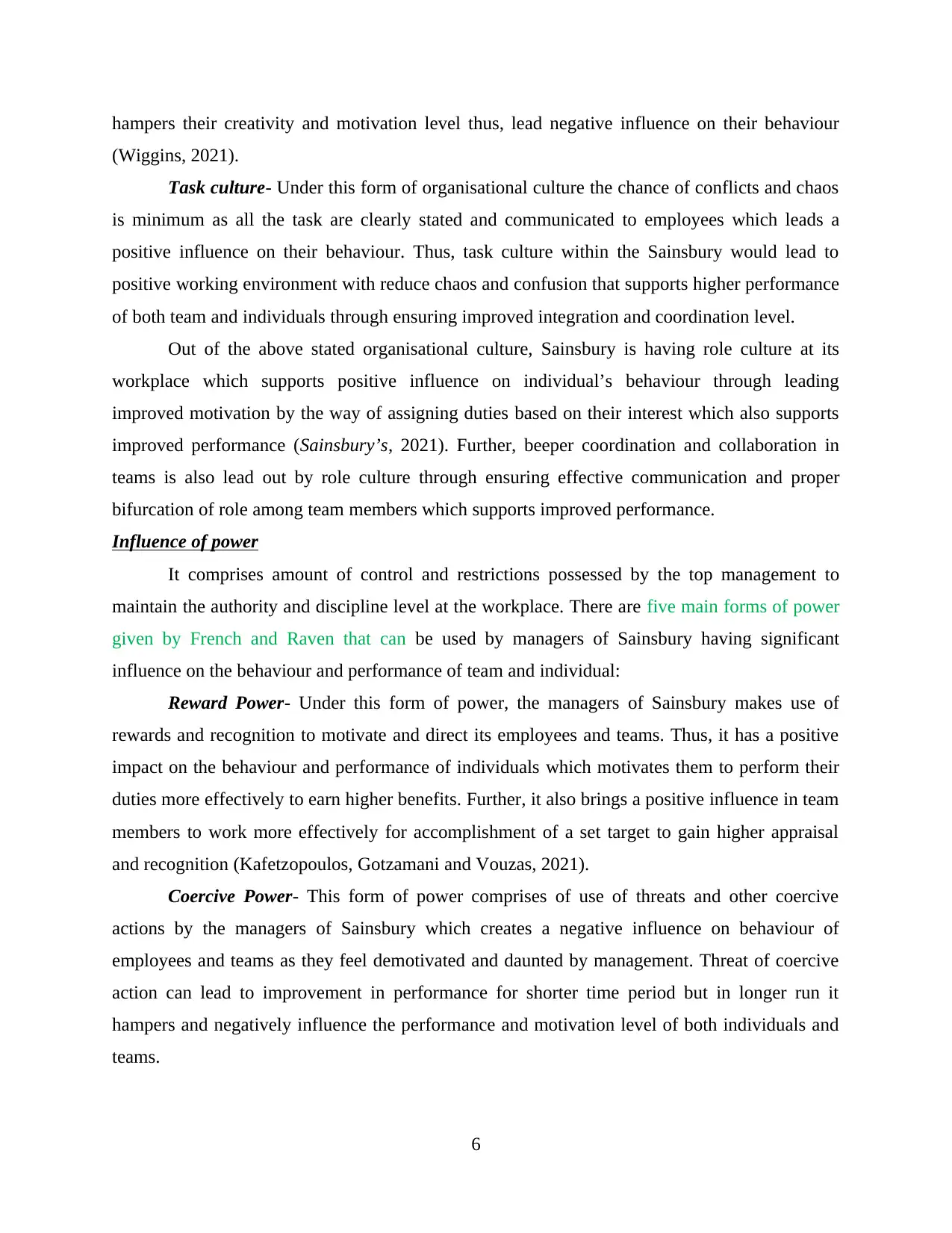
hampers their creativity and motivation level thus, lead negative influence on their behaviour
(Wiggins, 2021).
Task culture- Under this form of organisational culture the chance of conflicts and chaos
is minimum as all the task are clearly stated and communicated to employees which leads a
positive influence on their behaviour. Thus, task culture within the Sainsbury would lead to
positive working environment with reduce chaos and confusion that supports higher performance
of both team and individuals through ensuring improved integration and coordination level.
Out of the above stated organisational culture, Sainsbury is having role culture at its
workplace which supports positive influence on individual’s behaviour through leading
improved motivation by the way of assigning duties based on their interest which also supports
improved performance (Sainsbury’s, 2021). Further, beeper coordination and collaboration in
teams is also lead out by role culture through ensuring effective communication and proper
bifurcation of role among team members which supports improved performance.
Influence of power
It comprises amount of control and restrictions possessed by the top management to
maintain the authority and discipline level at the workplace. There are five main forms of power
given by French and Raven that can be used by managers of Sainsbury having significant
influence on the behaviour and performance of team and individual:
Reward Power- Under this form of power, the managers of Sainsbury makes use of
rewards and recognition to motivate and direct its employees and teams. Thus, it has a positive
impact on the behaviour and performance of individuals which motivates them to perform their
duties more effectively to earn higher benefits. Further, it also brings a positive influence in team
members to work more effectively for accomplishment of a set target to gain higher appraisal
and recognition (Kafetzopoulos, Gotzamani and Vouzas, 2021).
Coercive Power- This form of power comprises of use of threats and other coercive
actions by the managers of Sainsbury which creates a negative influence on behaviour of
employees and teams as they feel demotivated and daunted by management. Threat of coercive
action can lead to improvement in performance for shorter time period but in longer run it
hampers and negatively influence the performance and motivation level of both individuals and
teams.
6
(Wiggins, 2021).
Task culture- Under this form of organisational culture the chance of conflicts and chaos
is minimum as all the task are clearly stated and communicated to employees which leads a
positive influence on their behaviour. Thus, task culture within the Sainsbury would lead to
positive working environment with reduce chaos and confusion that supports higher performance
of both team and individuals through ensuring improved integration and coordination level.
Out of the above stated organisational culture, Sainsbury is having role culture at its
workplace which supports positive influence on individual’s behaviour through leading
improved motivation by the way of assigning duties based on their interest which also supports
improved performance (Sainsbury’s, 2021). Further, beeper coordination and collaboration in
teams is also lead out by role culture through ensuring effective communication and proper
bifurcation of role among team members which supports improved performance.
Influence of power
It comprises amount of control and restrictions possessed by the top management to
maintain the authority and discipline level at the workplace. There are five main forms of power
given by French and Raven that can be used by managers of Sainsbury having significant
influence on the behaviour and performance of team and individual:
Reward Power- Under this form of power, the managers of Sainsbury makes use of
rewards and recognition to motivate and direct its employees and teams. Thus, it has a positive
impact on the behaviour and performance of individuals which motivates them to perform their
duties more effectively to earn higher benefits. Further, it also brings a positive influence in team
members to work more effectively for accomplishment of a set target to gain higher appraisal
and recognition (Kafetzopoulos, Gotzamani and Vouzas, 2021).
Coercive Power- This form of power comprises of use of threats and other coercive
actions by the managers of Sainsbury which creates a negative influence on behaviour of
employees and teams as they feel demotivated and daunted by management. Threat of coercive
action can lead to improvement in performance for shorter time period but in longer run it
hampers and negatively influence the performance and motivation level of both individuals and
teams.
6
⊘ This is a preview!⊘
Do you want full access?
Subscribe today to unlock all pages.

Trusted by 1+ million students worldwide
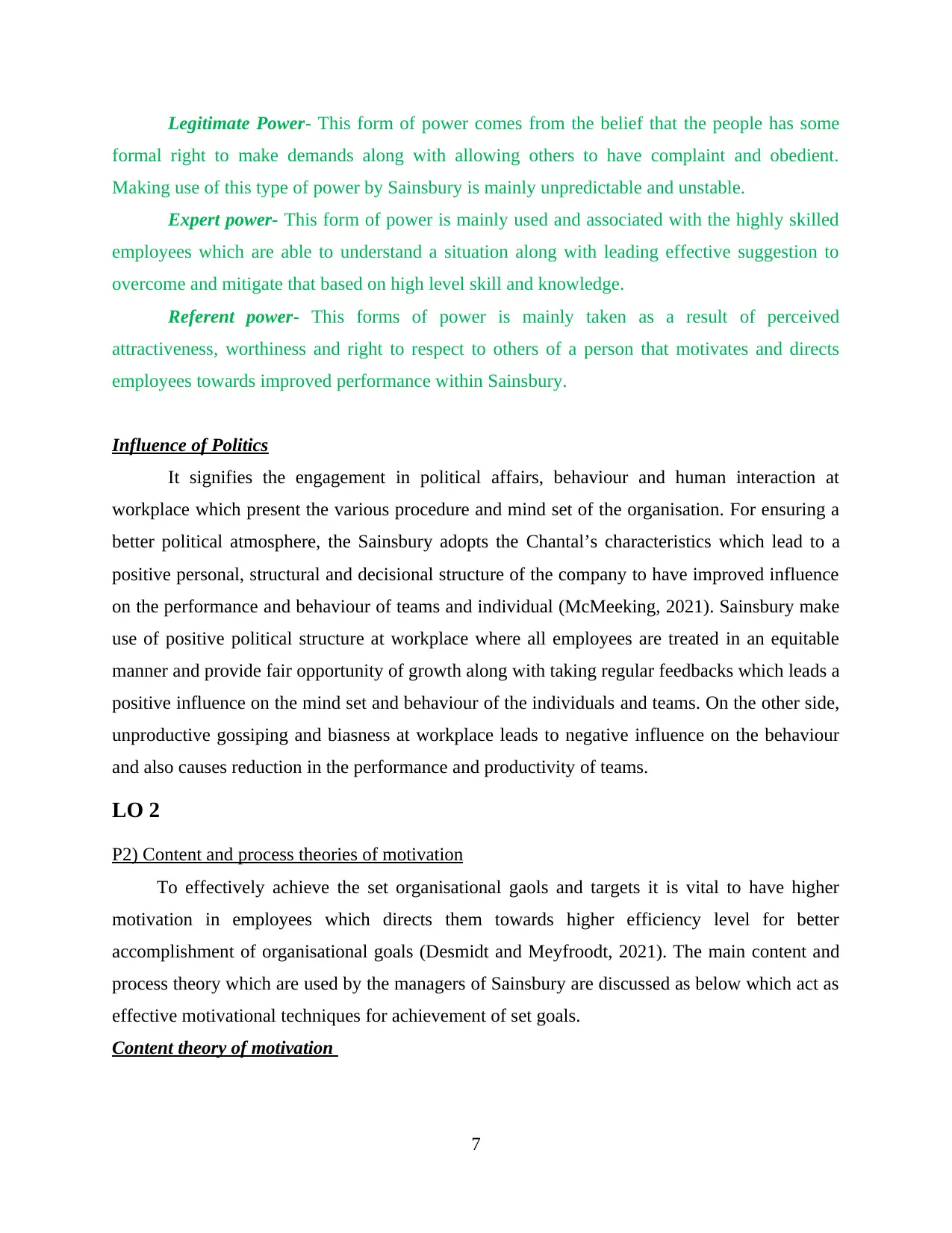
Legitimate Power- This form of power comes from the belief that the people has some
formal right to make demands along with allowing others to have complaint and obedient.
Making use of this type of power by Sainsbury is mainly unpredictable and unstable.
Expert power- This form of power is mainly used and associated with the highly skilled
employees which are able to understand a situation along with leading effective suggestion to
overcome and mitigate that based on high level skill and knowledge.
Referent power- This forms of power is mainly taken as a result of perceived
attractiveness, worthiness and right to respect to others of a person that motivates and directs
employees towards improved performance within Sainsbury.
Influence of Politics
It signifies the engagement in political affairs, behaviour and human interaction at
workplace which present the various procedure and mind set of the organisation. For ensuring a
better political atmosphere, the Sainsbury adopts the Chantal’s characteristics which lead to a
positive personal, structural and decisional structure of the company to have improved influence
on the performance and behaviour of teams and individual (McMeeking, 2021). Sainsbury make
use of positive political structure at workplace where all employees are treated in an equitable
manner and provide fair opportunity of growth along with taking regular feedbacks which leads a
positive influence on the mind set and behaviour of the individuals and teams. On the other side,
unproductive gossiping and biasness at workplace leads to negative influence on the behaviour
and also causes reduction in the performance and productivity of teams.
LO 2
P2) Content and process theories of motivation
To effectively achieve the set organisational gaols and targets it is vital to have higher
motivation in employees which directs them towards higher efficiency level for better
accomplishment of organisational goals (Desmidt and Meyfroodt, 2021). The main content and
process theory which are used by the managers of Sainsbury are discussed as below which act as
effective motivational techniques for achievement of set goals.
Content theory of motivation
7
formal right to make demands along with allowing others to have complaint and obedient.
Making use of this type of power by Sainsbury is mainly unpredictable and unstable.
Expert power- This form of power is mainly used and associated with the highly skilled
employees which are able to understand a situation along with leading effective suggestion to
overcome and mitigate that based on high level skill and knowledge.
Referent power- This forms of power is mainly taken as a result of perceived
attractiveness, worthiness and right to respect to others of a person that motivates and directs
employees towards improved performance within Sainsbury.
Influence of Politics
It signifies the engagement in political affairs, behaviour and human interaction at
workplace which present the various procedure and mind set of the organisation. For ensuring a
better political atmosphere, the Sainsbury adopts the Chantal’s characteristics which lead to a
positive personal, structural and decisional structure of the company to have improved influence
on the performance and behaviour of teams and individual (McMeeking, 2021). Sainsbury make
use of positive political structure at workplace where all employees are treated in an equitable
manner and provide fair opportunity of growth along with taking regular feedbacks which leads a
positive influence on the mind set and behaviour of the individuals and teams. On the other side,
unproductive gossiping and biasness at workplace leads to negative influence on the behaviour
and also causes reduction in the performance and productivity of teams.
LO 2
P2) Content and process theories of motivation
To effectively achieve the set organisational gaols and targets it is vital to have higher
motivation in employees which directs them towards higher efficiency level for better
accomplishment of organisational goals (Desmidt and Meyfroodt, 2021). The main content and
process theory which are used by the managers of Sainsbury are discussed as below which act as
effective motivational techniques for achievement of set goals.
Content theory of motivation
7
Paraphrase This Document
Need a fresh take? Get an instant paraphrase of this document with our AI Paraphraser
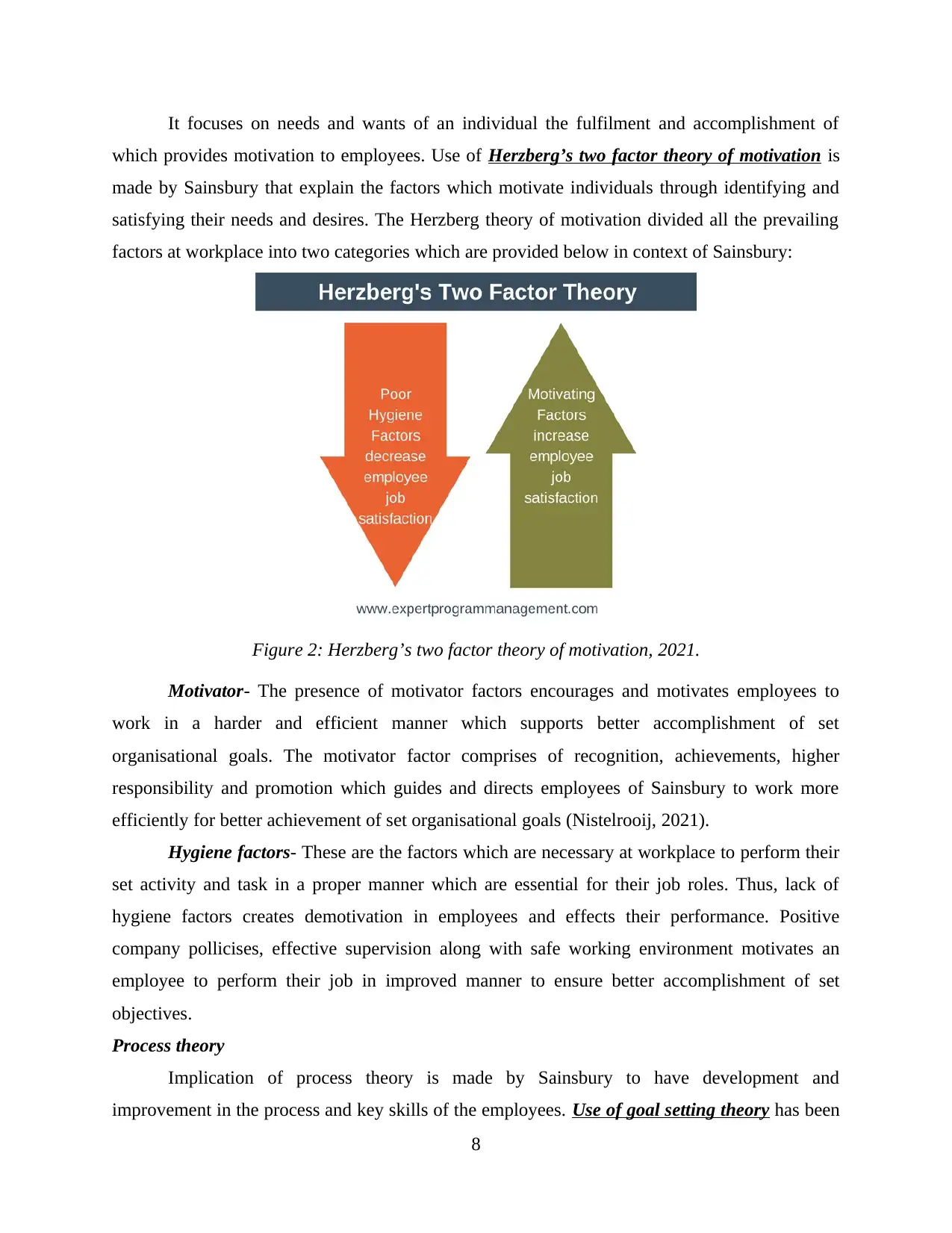
It focuses on needs and wants of an individual the fulfilment and accomplishment of
which provides motivation to employees. Use of Herzberg’s two factor theory of motivation is
made by Sainsbury that explain the factors which motivate individuals through identifying and
satisfying their needs and desires. The Herzberg theory of motivation divided all the prevailing
factors at workplace into two categories which are provided below in context of Sainsbury:
Figure 2: Herzberg’s two factor theory of motivation, 2021.
Motivator- The presence of motivator factors encourages and motivates employees to
work in a harder and efficient manner which supports better accomplishment of set
organisational goals. The motivator factor comprises of recognition, achievements, higher
responsibility and promotion which guides and directs employees of Sainsbury to work more
efficiently for better achievement of set organisational goals (Nistelrooij, 2021).
Hygiene factors- These are the factors which are necessary at workplace to perform their
set activity and task in a proper manner which are essential for their job roles. Thus, lack of
hygiene factors creates demotivation in employees and effects their performance. Positive
company pollicises, effective supervision along with safe working environment motivates an
employee to perform their job in improved manner to ensure better accomplishment of set
objectives.
Process theory
Implication of process theory is made by Sainsbury to have development and
improvement in the process and key skills of the employees. Use of goal setting theory has been
8
which provides motivation to employees. Use of Herzberg’s two factor theory of motivation is
made by Sainsbury that explain the factors which motivate individuals through identifying and
satisfying their needs and desires. The Herzberg theory of motivation divided all the prevailing
factors at workplace into two categories which are provided below in context of Sainsbury:
Figure 2: Herzberg’s two factor theory of motivation, 2021.
Motivator- The presence of motivator factors encourages and motivates employees to
work in a harder and efficient manner which supports better accomplishment of set
organisational goals. The motivator factor comprises of recognition, achievements, higher
responsibility and promotion which guides and directs employees of Sainsbury to work more
efficiently for better achievement of set organisational goals (Nistelrooij, 2021).
Hygiene factors- These are the factors which are necessary at workplace to perform their
set activity and task in a proper manner which are essential for their job roles. Thus, lack of
hygiene factors creates demotivation in employees and effects their performance. Positive
company pollicises, effective supervision along with safe working environment motivates an
employee to perform their job in improved manner to ensure better accomplishment of set
objectives.
Process theory
Implication of process theory is made by Sainsbury to have development and
improvement in the process and key skills of the employees. Use of goal setting theory has been
8
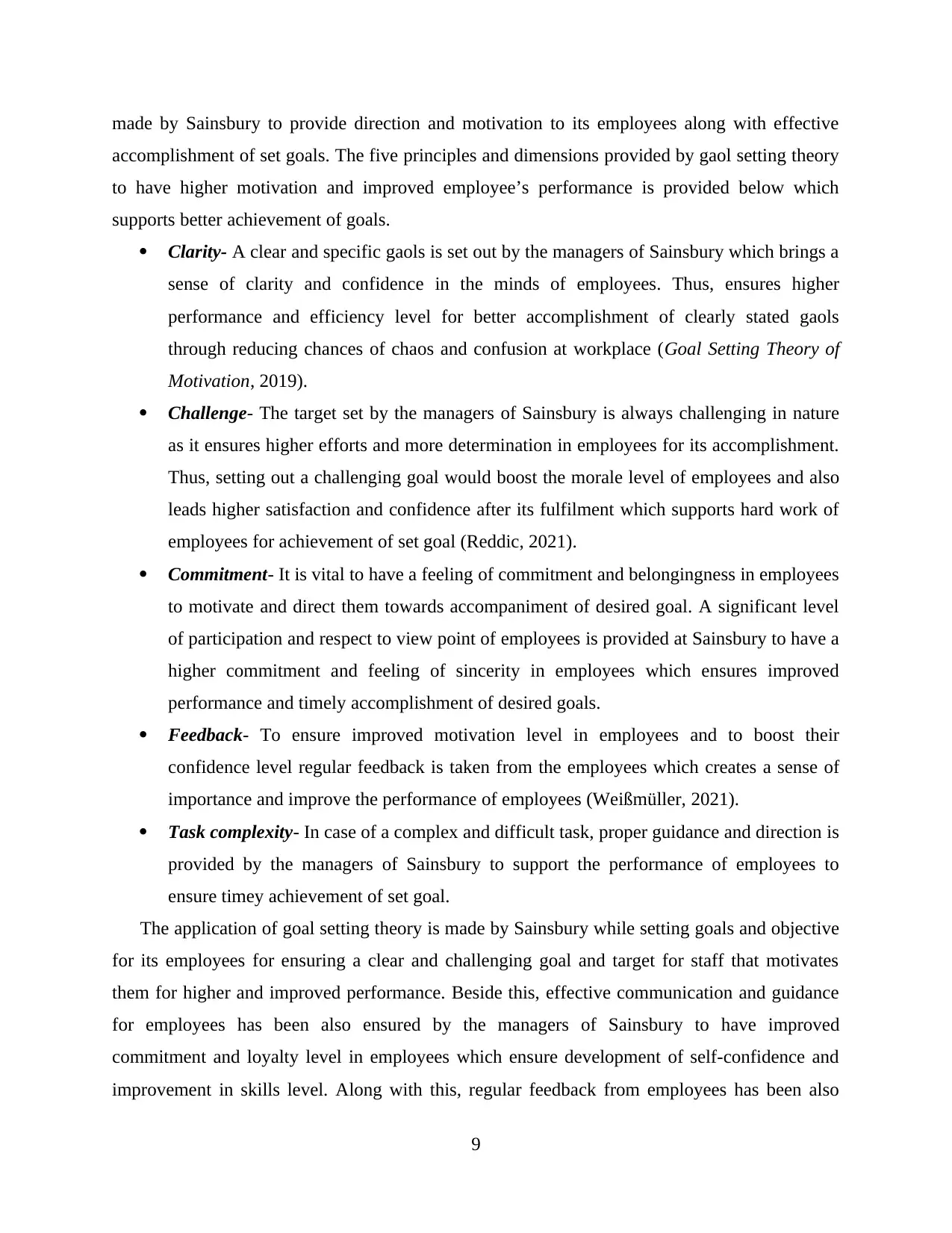
made by Sainsbury to provide direction and motivation to its employees along with effective
accomplishment of set goals. The five principles and dimensions provided by gaol setting theory
to have higher motivation and improved employee’s performance is provided below which
supports better achievement of goals.
Clarity- A clear and specific gaols is set out by the managers of Sainsbury which brings a
sense of clarity and confidence in the minds of employees. Thus, ensures higher
performance and efficiency level for better accomplishment of clearly stated gaols
through reducing chances of chaos and confusion at workplace (Goal Setting Theory of
Motivation, 2019).
Challenge- The target set by the managers of Sainsbury is always challenging in nature
as it ensures higher efforts and more determination in employees for its accomplishment.
Thus, setting out a challenging goal would boost the morale level of employees and also
leads higher satisfaction and confidence after its fulfilment which supports hard work of
employees for achievement of set goal (Reddic, 2021).
Commitment- It is vital to have a feeling of commitment and belongingness in employees
to motivate and direct them towards accompaniment of desired goal. A significant level
of participation and respect to view point of employees is provided at Sainsbury to have a
higher commitment and feeling of sincerity in employees which ensures improved
performance and timely accomplishment of desired goals.
Feedback- To ensure improved motivation level in employees and to boost their
confidence level regular feedback is taken from the employees which creates a sense of
importance and improve the performance of employees (Weißmüller, 2021).
Task complexity- In case of a complex and difficult task, proper guidance and direction is
provided by the managers of Sainsbury to support the performance of employees to
ensure timey achievement of set goal.
The application of goal setting theory is made by Sainsbury while setting goals and objective
for its employees for ensuring a clear and challenging goal and target for staff that motivates
them for higher and improved performance. Beside this, effective communication and guidance
for employees has been also ensured by the managers of Sainsbury to have improved
commitment and loyalty level in employees which ensure development of self-confidence and
improvement in skills level. Along with this, regular feedback from employees has been also
9
accomplishment of set goals. The five principles and dimensions provided by gaol setting theory
to have higher motivation and improved employee’s performance is provided below which
supports better achievement of goals.
Clarity- A clear and specific gaols is set out by the managers of Sainsbury which brings a
sense of clarity and confidence in the minds of employees. Thus, ensures higher
performance and efficiency level for better accomplishment of clearly stated gaols
through reducing chances of chaos and confusion at workplace (Goal Setting Theory of
Motivation, 2019).
Challenge- The target set by the managers of Sainsbury is always challenging in nature
as it ensures higher efforts and more determination in employees for its accomplishment.
Thus, setting out a challenging goal would boost the morale level of employees and also
leads higher satisfaction and confidence after its fulfilment which supports hard work of
employees for achievement of set goal (Reddic, 2021).
Commitment- It is vital to have a feeling of commitment and belongingness in employees
to motivate and direct them towards accompaniment of desired goal. A significant level
of participation and respect to view point of employees is provided at Sainsbury to have a
higher commitment and feeling of sincerity in employees which ensures improved
performance and timely accomplishment of desired goals.
Feedback- To ensure improved motivation level in employees and to boost their
confidence level regular feedback is taken from the employees which creates a sense of
importance and improve the performance of employees (Weißmüller, 2021).
Task complexity- In case of a complex and difficult task, proper guidance and direction is
provided by the managers of Sainsbury to support the performance of employees to
ensure timey achievement of set goal.
The application of goal setting theory is made by Sainsbury while setting goals and objective
for its employees for ensuring a clear and challenging goal and target for staff that motivates
them for higher and improved performance. Beside this, effective communication and guidance
for employees has been also ensured by the managers of Sainsbury to have improved
commitment and loyalty level in employees which ensure development of self-confidence and
improvement in skills level. Along with this, regular feedback from employees has been also
9
⊘ This is a preview!⊘
Do you want full access?
Subscribe today to unlock all pages.

Trusted by 1+ million students worldwide
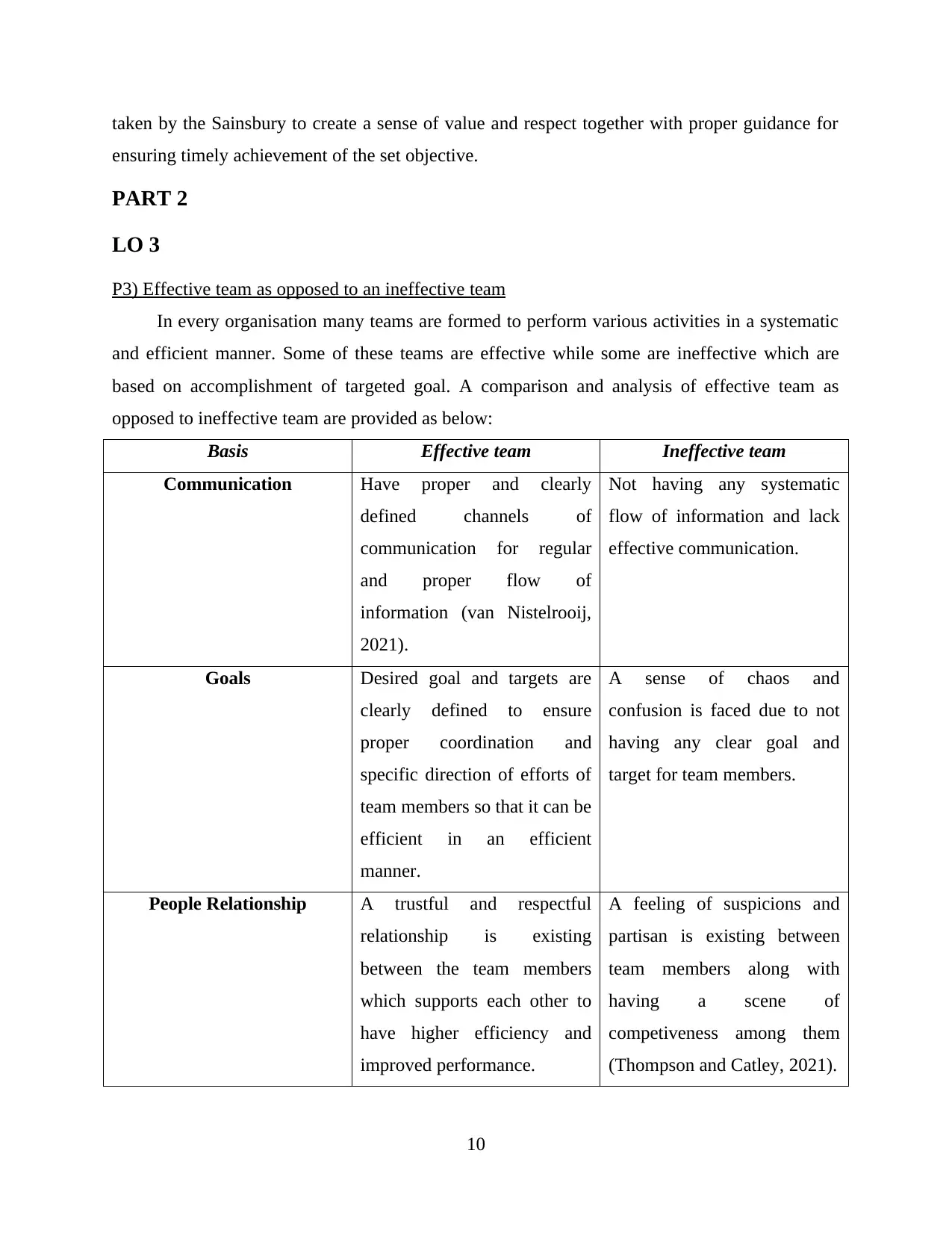
taken by the Sainsbury to create a sense of value and respect together with proper guidance for
ensuring timely achievement of the set objective.
PART 2
LO 3
P3) Effective team as opposed to an ineffective team
In every organisation many teams are formed to perform various activities in a systematic
and efficient manner. Some of these teams are effective while some are ineffective which are
based on accomplishment of targeted goal. A comparison and analysis of effective team as
opposed to ineffective team are provided as below:
Basis Effective team Ineffective team
Communication Have proper and clearly
defined channels of
communication for regular
and proper flow of
information (van Nistelrooij,
2021).
Not having any systematic
flow of information and lack
effective communication.
Goals Desired goal and targets are
clearly defined to ensure
proper coordination and
specific direction of efforts of
team members so that it can be
efficient in an efficient
manner.
A sense of chaos and
confusion is faced due to not
having any clear goal and
target for team members.
People Relationship A trustful and respectful
relationship is existing
between the team members
which supports each other to
have higher efficiency and
improved performance.
A feeling of suspicions and
partisan is existing between
team members along with
having a scene of
competiveness among them
(Thompson and Catley, 2021).
10
ensuring timely achievement of the set objective.
PART 2
LO 3
P3) Effective team as opposed to an ineffective team
In every organisation many teams are formed to perform various activities in a systematic
and efficient manner. Some of these teams are effective while some are ineffective which are
based on accomplishment of targeted goal. A comparison and analysis of effective team as
opposed to ineffective team are provided as below:
Basis Effective team Ineffective team
Communication Have proper and clearly
defined channels of
communication for regular
and proper flow of
information (van Nistelrooij,
2021).
Not having any systematic
flow of information and lack
effective communication.
Goals Desired goal and targets are
clearly defined to ensure
proper coordination and
specific direction of efforts of
team members so that it can be
efficient in an efficient
manner.
A sense of chaos and
confusion is faced due to not
having any clear goal and
target for team members.
People Relationship A trustful and respectful
relationship is existing
between the team members
which supports each other to
have higher efficiency and
improved performance.
A feeling of suspicions and
partisan is existing between
team members along with
having a scene of
competiveness among them
(Thompson and Catley, 2021).
10
Paraphrase This Document
Need a fresh take? Get an instant paraphrase of this document with our AI Paraphraser
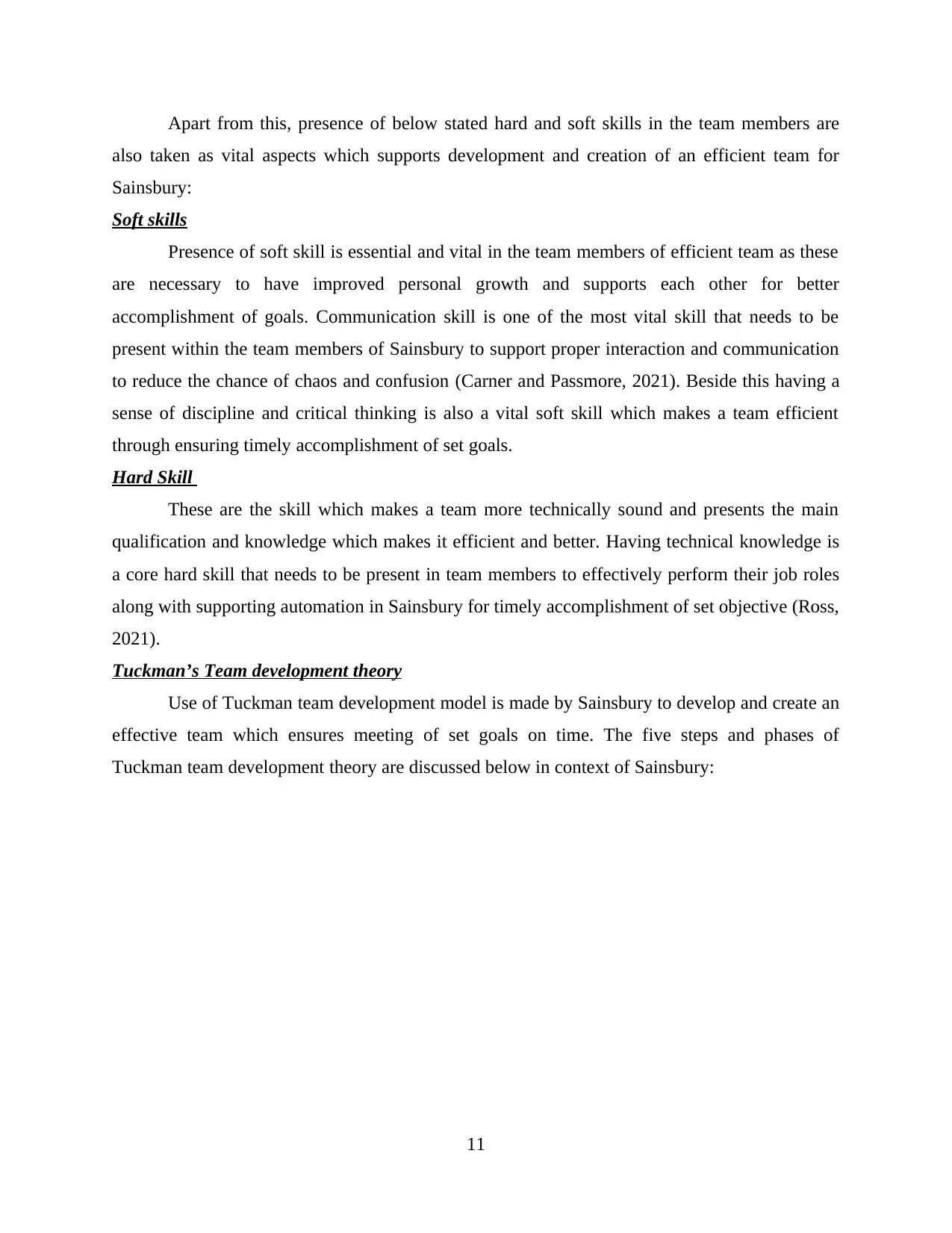
Apart from this, presence of below stated hard and soft skills in the team members are
also taken as vital aspects which supports development and creation of an efficient team for
Sainsbury:
Soft skills
Presence of soft skill is essential and vital in the team members of efficient team as these
are necessary to have improved personal growth and supports each other for better
accomplishment of goals. Communication skill is one of the most vital skill that needs to be
present within the team members of Sainsbury to support proper interaction and communication
to reduce the chance of chaos and confusion (Carner and Passmore, 2021). Beside this having a
sense of discipline and critical thinking is also a vital soft skill which makes a team efficient
through ensuring timely accomplishment of set goals.
Hard Skill
These are the skill which makes a team more technically sound and presents the main
qualification and knowledge which makes it efficient and better. Having technical knowledge is
a core hard skill that needs to be present in team members to effectively perform their job roles
along with supporting automation in Sainsbury for timely accomplishment of set objective (Ross,
2021).
Tuckman’s Team development theory
Use of Tuckman team development model is made by Sainsbury to develop and create an
effective team which ensures meeting of set goals on time. The five steps and phases of
Tuckman team development theory are discussed below in context of Sainsbury:
11
also taken as vital aspects which supports development and creation of an efficient team for
Sainsbury:
Soft skills
Presence of soft skill is essential and vital in the team members of efficient team as these
are necessary to have improved personal growth and supports each other for better
accomplishment of goals. Communication skill is one of the most vital skill that needs to be
present within the team members of Sainsbury to support proper interaction and communication
to reduce the chance of chaos and confusion (Carner and Passmore, 2021). Beside this having a
sense of discipline and critical thinking is also a vital soft skill which makes a team efficient
through ensuring timely accomplishment of set goals.
Hard Skill
These are the skill which makes a team more technically sound and presents the main
qualification and knowledge which makes it efficient and better. Having technical knowledge is
a core hard skill that needs to be present in team members to effectively perform their job roles
along with supporting automation in Sainsbury for timely accomplishment of set objective (Ross,
2021).
Tuckman’s Team development theory
Use of Tuckman team development model is made by Sainsbury to develop and create an
effective team which ensures meeting of set goals on time. The five steps and phases of
Tuckman team development theory are discussed below in context of Sainsbury:
11
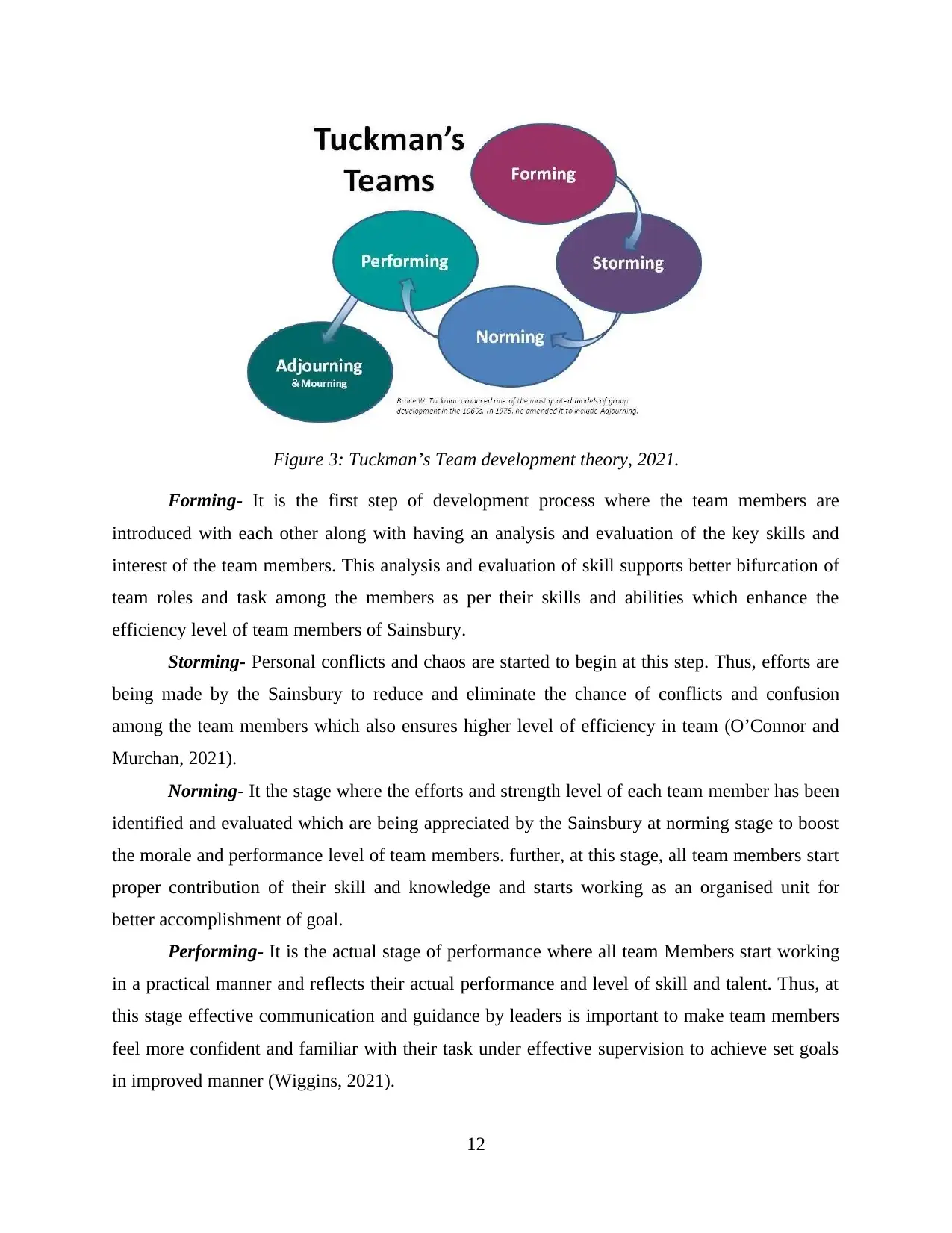
Figure 3: Tuckman’s Team development theory, 2021.
Forming- It is the first step of development process where the team members are
introduced with each other along with having an analysis and evaluation of the key skills and
interest of the team members. This analysis and evaluation of skill supports better bifurcation of
team roles and task among the members as per their skills and abilities which enhance the
efficiency level of team members of Sainsbury.
Storming- Personal conflicts and chaos are started to begin at this step. Thus, efforts are
being made by the Sainsbury to reduce and eliminate the chance of conflicts and confusion
among the team members which also ensures higher level of efficiency in team (O’Connor and
Murchan, 2021).
Norming- It the stage where the efforts and strength level of each team member has been
identified and evaluated which are being appreciated by the Sainsbury at norming stage to boost
the morale and performance level of team members. further, at this stage, all team members start
proper contribution of their skill and knowledge and starts working as an organised unit for
better accomplishment of goal.
Performing- It is the actual stage of performance where all team Members start working
in a practical manner and reflects their actual performance and level of skill and talent. Thus, at
this stage effective communication and guidance by leaders is important to make team members
feel more confident and familiar with their task under effective supervision to achieve set goals
in improved manner (Wiggins, 2021).
12
Forming- It is the first step of development process where the team members are
introduced with each other along with having an analysis and evaluation of the key skills and
interest of the team members. This analysis and evaluation of skill supports better bifurcation of
team roles and task among the members as per their skills and abilities which enhance the
efficiency level of team members of Sainsbury.
Storming- Personal conflicts and chaos are started to begin at this step. Thus, efforts are
being made by the Sainsbury to reduce and eliminate the chance of conflicts and confusion
among the team members which also ensures higher level of efficiency in team (O’Connor and
Murchan, 2021).
Norming- It the stage where the efforts and strength level of each team member has been
identified and evaluated which are being appreciated by the Sainsbury at norming stage to boost
the morale and performance level of team members. further, at this stage, all team members start
proper contribution of their skill and knowledge and starts working as an organised unit for
better accomplishment of goal.
Performing- It is the actual stage of performance where all team Members start working
in a practical manner and reflects their actual performance and level of skill and talent. Thus, at
this stage effective communication and guidance by leaders is important to make team members
feel more confident and familiar with their task under effective supervision to achieve set goals
in improved manner (Wiggins, 2021).
12
⊘ This is a preview!⊘
Do you want full access?
Subscribe today to unlock all pages.

Trusted by 1+ million students worldwide
1 out of 16
Related Documents
Your All-in-One AI-Powered Toolkit for Academic Success.
+13062052269
info@desklib.com
Available 24*7 on WhatsApp / Email
![[object Object]](/_next/static/media/star-bottom.7253800d.svg)
Unlock your academic potential
Copyright © 2020–2025 A2Z Services. All Rights Reserved. Developed and managed by ZUCOL.





